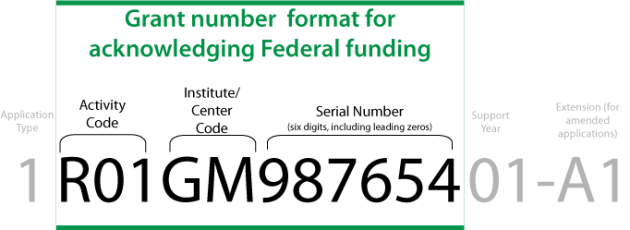So you finally have a critical mass of data and results and are ready to publish or otherwise communicate your work to the greater UCSC community and the outside world and global scientific community. Congratulations!
Ensuring that you properly acknowledge all funding sources for your work is critical for ensuring transparent funding communication and for ensuring the impact of your research is properly attributed to those funding agencies. But how do you go about communicating this, particularly when “real estate” may be limited such as on a crowded scientific poster or PowerPoint slide?
The guidelines provided below are taken from the NIH Central Resource for Grants and Funding Information and should be generally applicable to your funding agency. However, please be sure that your specific funding source(s) do not have additional or more strict requirements.
Funding Acknowledgements Have Three (3) Key Parts:
1. A specific acknowledgment of grant support
Be sure to only cite the grant(s) that supported the research described in your article, poster, or publication. Example:
Research reported in this [publication/poster/presentation/press release] was supported by [name of the Institute(s), Center, or other NIH offices] of the [Funding Agency, such as National Institutes of Health] under award number [specific grant number(s)].
If you are acknowledging a NIH grant, please be sure that the grant number is formatted in the manner shown:

2. An acknowledgement of the level of funding
Publications, press releases, requests for proposals (RFP), and other documents and public statements may require an acknowledgement of the level of funding (i.e. NIH funded work). This second sentence should acknowledge and clearly state:
- The percentage and dollar amounts of the total program or project costs financed with Federal money
- The percentage and dollar amount of the total costs financed by nongovernmental sources
3. A disclaimer for your work in relation to the funding agency
This statement should simply clarify that the statements made in your work do not reflect the funding agency. Example:
The content is solely the responsibility of the authors and does not necessarily represent the official views of the [Funding Agency].
The IBSC and the NIH also strongly encourage that if your work has used or generated HeLa cells and/or associated whole genome sequence data to acknowledge Henrietta Lacks and her family.
How Do I know If an Acknowledgement Is Necessary?
If the publication, poster, or presentation arose directly as part of specific funding, that funding should be acknowledged. Similarly as long as the publication, poster, or presentation are within the scope of the award, the funding award should be acknowledged. In general, you can ask yourself the following questions to determine if an acknowledgement is necessary. If you answer yes to any of these questions, an acknowledgement is probably necessary and highly recommended:
- Did people listed as contributors under the funding award contribute towards the publication, poster, presentation, etc.?
- Where the experiments described in the publication, poster, presentation, etc. supported in any way by the funding award, including both conducting experiments and analyzing the resulting data?
- Does the work described in the publication, poster, presentation, etc. have a clear and apparent link to the specific aims and objectives of the funding grant?
Are there specific requirements for my Training Program?
Please find sample acknowledgements below for the IRACDA, CIRM, and T32 Training Programs administered by the IBSC. These are provided as examples only and should be modified to meet the requirements of any additional funding agencies that support your work.
IRACDA Sample Funding Acknowledgement
Research reported here was supported by the National Institutes of Health (NIH) under award number K12GM139185 and the Institute for the Biology of Stem Cells (IBSC) at UC Santa Cruz. The content is solely the responsibility of the authors and does not necessarily represent the official views of the NIH or the IBSC.
*If publishing a funding level acknowledgement should follow.
CIRM Sample Funding Acknowledgement
Research reported here was supported by the California Institute for Regenerative Medicine (CIRM) under award number EDUC4-12759 and the Institute for the Biology of Stem Cells (IBSC) at UC Santa Cruz. The content is solely the responsibility of the authors and does not necessarily represent the official views of CIRM or the IBSC.
*If publishing a funding level acknowledgement should follow.
T32 Sample Funding Acknowledgement
Research reported here was supported by the National Institutes of Health (NIH) and Eunice Kennedy Shriver National Institute of Child Health and Human Development (NIHCD) under award number T32HD108079 and the Institute for the Biology of Stem Cells (IBSC) at UC Santa Cruz. The content is solely the responsibility of the authors and does not necessarily represent the official views of the NIH/NICHD or the IBSC.
*If publishing a funding level acknowledgement should follow.
GAIN Sample Funding Acknowledgement
Research reported here was supported by the Genentech Academic Inspiration Network (GAIN) Foundation under award number G-89316 and the Institute for the Biology of Stem Cells (IBSC) at UC Santa Cruz. The content is solely the responsibility of the authors and does not necessarily represent the official views of the GAIN Foundation or the IBSC.
*If publishing a funding level acknowledgement should follow.
Shared Core Facilities Sample Acknowledgement
Research reported here was acknowledges core support from the UCSC Institute for the Biology of Stem Cells (IBSC) and CIRM Shared Stem Cell Facilities (CL1-00506-1,2), CIRM Major Facilities (FA1-00617-1) and National Institutes of Health confocal grant: 1S10OD23528-01.
*Please be sure to include the appropriate RRID for the core facilities utilized. If publishing a funding level acknowledgement should follow.
Core Facility RRID Information
For more information on how to properly cite funding sources, particularly Federal sources, please refer the the NIH Grants Office.
